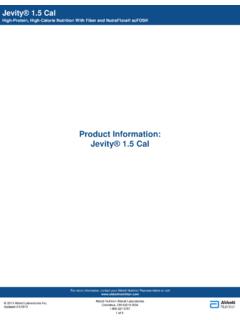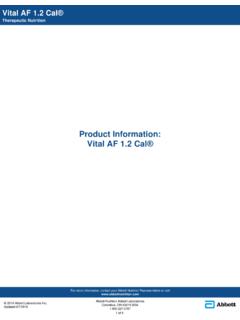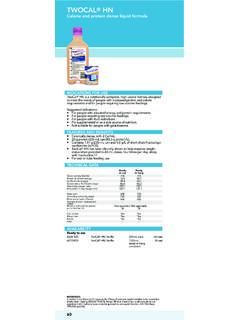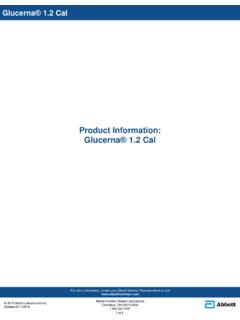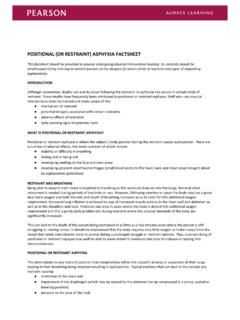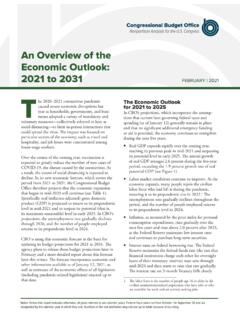Transcription of Parents’ Guide to Pediatric Tube Feeding - Abbott Nutrition
1 Parents Guide to Pediatric Tube FeedingXXContentsIntroductionFinding Community SupportUnderstanding the Tube Feeding SystemMonitoring Your Child s Response to Tube Feeding Navigating Your Doctor VisitsTube Feeding Monitoring ChecklistMedication RecordNotesGlossary34681820283032 Parents Guide to Pediatric Tube Feeding | 1We know that tube Feeding brings major life changes to your entire family. But you re not alone. We hope you find this Guide a useful, practical resource that can help your child tube feed successfully at home.
2 You ll find step-by-step instructions on handling issues you face every day, from monitoring your child for infections to preparing for a doctor s appointment. The Guide includes worksheets (P. 20-31) that make it simple to record important information about your child s progress. We ve also added a helpful glossary (P. 32-34) that you can refer to if you come across any unfamiliar technical and medical support form the foundation of tube Feeding success, we believe that emotional support is just as important. Hopefully, you ll find resources in this Guide that make your family s journey easier.
3 IntroductionParents Guide to Pediatric Tube Feeding | 32 Finding Community SupportThe community organizations listed here offer support and guidance to help you and your child adjust successfully to life with tube Feeding . Visit the links below to find educational resources, support groups and the opportunity to connect with other families in your situation. The Oley Foundation The Oley Foundation is a nonprofit organization for people who depend on home enteral (tube) Feeding or parenteral (intravenous) include.
4 N Access to a network of individuals and caregivers who are involved in tube Feeding at homen Education and troubleshooting materialsn Support groupsn Bi-monthly newslettern Equipment and supply exchangen Annual conference for patients, family members and caregiversThe Feeding Tube Awareness Foundation This nonprofit, volunteer-run organization was founded by parents of tube-fed children. Its mission is to provide a forum for parents to share their practical experience with tube Feeding and to raise awareness of tube Feeding in the community.
5 You ll enjoy access to: n A network of parents of children who tube feedn The world s largest support group for tube Feeding families ( )n Resources to help you care for your tube-fed childn Education and troubleshooting materials4 Parents Guide to Pediatric Tube Feeding | the Tube Feeding SystemA tube Feeding system has a lot of parts and pieces. This diagram can help you see how they all work bagPouring formula into Feeding bagConnecting Feeding bag tubing to Feeding portEnteral Feeding pumpDrip chamberParents Guide to Pediatric Tube Feeding | 7 Monitoring Your Child s Response to Tube FeedingBy keeping close track of your child s reactions to tube Feeding , you provide accurate information for your doctor and save yourself time.
6 When you write things down right away, you don t have to spend time later trying to recall important details when they re no longer fresh in your Tube Feeding Monitoring Checklist (P. 20-27) is an easy way to track signs and symptoms that can provide information important to your child s health. The Medication Record (P. 28-29) allows you to monitor your child s medication schedule. Sharing these records with your physician can help him or her identify and address any issues that may is important to monitor and document the presence (or absence) of symptoms associated with intolerance, as it can lead to complications such as dehydration.
7 Typically, patients experiencing intolerance to tube Feeding will have more than one of these patients show signs associated with intolerance, it is important to determine whether the intolerance is related to the formula or something else. Please inform your doctor if you suspect your child is experiencing any symptoms of intolerance. Medication RecordTube Feeding Monitoring Checklist8 Parents Guide to Pediatric Tube Feeding | 9 Look for:n Nausean Vomitingn Diarrhean Bloatingn Constipationn Abdominal discomfortFeeding IntoleranceNausea, Vomiting and Abdominal DiscomfortPossible CausesPrevention and TreatmentNot tolerating the formula Work with your health care provider to determine cause and talk to your doctor about switching to a tolerance going in too fast Begin at a slow rate.
8 Increase the rate and amount gradually over 24-48 spoiled or contaminated during preparation Wash and dry hands prior to preparing a Feeding or touching the Feeding tube. Avoid touching any part of the Feeding tube system that will come in contact with the formula. Record date and time on can after it is opened and store covered in the refrigerator. Discard unused formula after 48 hours or as recommended by formula patient position during and after Feeding Confirm tube placement prior to Feeding if recommended by your health care provider.
9 Elevate patient s head 30 degrees or more by propping up in bed or on a couch . Keep your child in a raised position for at least one hour after , esophagus or intestine not working properly The doctor may need to do an examination or other tests. Small bowel (jejunal Feeding or J-Tube Feeding ) should be given with a Feeding pump at a controlled rate. n Formula is the wrong temperature. Taking formula out of the refrigerator and administering it before it has had time to rise to room temperature can lead to abdominal cramping and other intolerance-related Medication side effects.
10 Many medications in liquid form contain sorbitol, a sugar alcohol that can cause diarrhea in some patients. In addition, medications can also interact with each other, leading to GI Patient is lying flat while receiving tube Volume of formula is too The stomach, esophagus or intestine may not be working properly due to one of these issues: Infection Delayed gastric emptying Malabsorption Maldigestionn Type of formula doesn t meet the patient s needs. n Formula is spoiled from contamination during preparation, storage or Formula is going in too fast.
